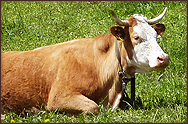
Each day, a cow spends 8 hours grazing and 10 hours ruminating. She can drink up to 100l of water and consume 50kg of grass.
At birth, only the abomasum* of the young calf (and other young ruminants) is developed and it can only digest milk. As it gradually begins to diversify its diet and to consume some vegetation, the ruminant digestive system (4 stomachs) progressively develops its functionality.
* abomasum: ruminant stomach pouch where gastric acid is secreted

The farm meadows provide 90% of the food intake of the herd. From April to November, the herd grazes the meadows and alpages. This represents the best value use of the grass.
In Winter, they are fed with hay which has been harvested, dried and stocked in a hay tower as well as silage. A cow needs 15kg of hay per day and significant quantities of water.
Their diet is complemented by cereals and mineral salts.
Following nature’s own cycle: the herd are nourished with harvested crops which have themselves been fertilised with manure formed from the cow dung mixed with their bedding material.













